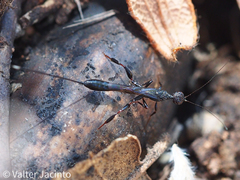Mealybug
Pseudococcidae
Insecta Pseudococcidae, commonly known as mealybugs, are a family of scale insects that are found in various habitats, including the Comunidad Valenciana. These small insects are often known for their appearance which resembles a tiny tuft of cotton, as they are covered with a waxy, white, powdery coating.
Mealybugs are notorious agricultural pests that affect a wide range of plants. They are particularly troublesome in warmer climates where they thrive, including regions like the Comunidad Valenciana. Their presence is most commonly associated with damaged plants, as they feed on plant juices, leading to the weakening or even death of the plant if infestations are severe.
- Appearance: Mealybugs are small, soft-bodied insects. They are usually white or grayish in color due to their waxy secretions. The adult female is wingless and has an elongated oval body, while the male, although rarely seen, tends to have wings.
- Lifecycle: Mealybugs undergo an incomplete metamorphosis consisting of egg, nymph, and adult stages. The female lays eggs in a protective cottony pouch, and upon hatching, nymphs, also known as crawlers, spread to find feeding sites.
- Habitat: These insects are usually found in sheltered areas around plants, preferring places like leaf axils, undersides of leaves, and plant roots.
- Impact on Agriculture: Mealybugs feed on plant sap, causing yellowing of leaves, stunted growth, and potentially plant death. They also excrete a sticky substance known as honeydew, which can lead to the growth of sooty mold on plants, affecting photosynthesis.
- Control Methods: Management of mealybug populations is essential to prevent significant plant damage. This includes cultural controls like removing infested plant parts, biological controls using natural predators like ladybugs, and chemical treatments in severe cases.
Understanding the life cycle and behavior of Pseudococcidae is crucial for effective management strategies, especially in agricultural areas like the Comunidad Valenciana where they can significantly impact crop yields.







